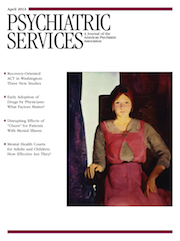Economic Impact of Inappropriate Benzodiazepine Prescribing and Related Drug Interactions Among Elderly Persons
Abstract
Objectives
The purpose of this study was to describe, from a health care system perspective, potentially inappropriate benzodiazepine prescribing among elderly persons in a publicly funded health system in Canada as well as health service use and costs associated with such prescriptions and the related drug interactions.
Methods
The sample (N=2,320) was representative of Quebec’s community-dwelling elderly population (≥65 years) and consisted of respondents to the 2006 ESA survey (Enquête sur la Santé des Aînés, or Survey on the Health of the Elderly). The definition of potentially inappropriate benzodiazepine prescription was based on Beers criteria and on the potential for benzodiazepine-related drug interactions. Using a retrospective design, logistic regressions tested the association between inappropriate prescribing and health service use incurred over 12 months. The cost analysis used a generalized linear model with a gamma distribution.
Results
Thirty-two percent (N=744) had received a benzodiazepine prescription, and 44% of this group received at least one potentially inappropriate prescription. Participants susceptible to benzodiazepine-related drug interactions, unlike those with inappropriate prescriptions according to Beers criteria, had a greater risk of hospitalizations and of emergency department and outpatient visits and higher health care costs ($3,076 higher per year, p<.001) than those with appropriate prescriptions.
Conclusions
Use of administrative and survey data permitted control for several factors, and a significant association between benzodiazepine-related drug interactions and health care costs among elderly persons was found. Research should further examine this association and evaluate the potential of shared medical electronic databases to decrease life-threatening drug interactions affecting this population.



